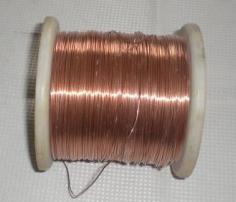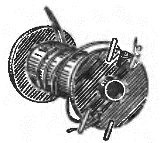How to wind a resistor with a coiled wire
When repairing thermal and electrical measuring devices, as well as electronic controllers, it is often necessary to wind wire resistors. They should have a bifilar non-inductive coil made of Manganese wire.
Manganese, unlike many other alloys, has the property of changing its own electrical resistance over time and gradually decreases sometimes to 1% of the initial value. This phenomenon is called natural aging.
This property in manganin is manifested whenever the so-called work hardening occurs as a result of the manganin wire manufacturing process or when winding it, as well as when cutting or bending shunt plates, when the hardness of manganin and its resistance increases.
Subsequently, spontaneous work hardening occurs and other structural changes occur in the manganin, causing not a decrease but an increase in resistance. However, full compensation for resistance changes is not obtained and the resulting resistance is still less than the original by a value not exceeding 1%.
If you do not expose the wound wire manganin artificial aging, this can lead to a change in the readings of the measuring device, for example, an electronic balanced bridge or potentiometerexceeding the device's error tolerance.
For the purpose of artificial aging of manganin wire, all coils of newly wound wire, as well as shunts, are heated and maintained at an elevated temperature or subjected to repeated heating and subsequent cooling.
 Manganese wire
Manganese wire
A wire-wound resistor during repair after the aging process, that is, a resistor with aged manganin, should be handled exclusively from the frame cheeks, but not from the coil, since pressing the fingers on the wire can accidentally "remove" the aging.
For the same reason, for the purpose of fastening, it is impossible to tighten the wound coil of manganin with an insulating film, that is, it is impossible to take actions that can lead to a violation of the structure of manganin formed during artificial aging.
When winding a resistor, use a wire of the same type with a remote (in diameter and insulation) wire, otherwise (in the absence of one type), determine by calculation the diameter of the wire and the number of turns that must be wound on the frame.
When calculating, two conditions are set:
-
power dissipated by the wire resistor should not exceed 0.05 -0.10 W for each square centimeter of the cooling surface, so that the heating of the resistor from the current flowing through it is within acceptable limits;
-
the voltage drop of the additional resistor should not be more than 100 V to exclude the possibility of breaking the insulation between turns in a bifilar winding.

Winding of bifilar wire on the frame
The coil is wound to turn by two wires folded together and wound simultaneously by two coils. The ends of these wires are soldered to the contacts of the box and begin to wind, focusing on the readings of the rev counter.
Resistance of a coiled wire should exceed the nominal value by 1 — 2%, so after artificial aging of the manganin wire, when its resistance decreases, it would be convenient to adjust the resistance value of the resistor to the nominal value.
At the end of the winding, the ends of the two wires are cleaned of insulation and soldered with PSr-45 or POS-40 solder with LTI-120 flux. The junction is coated with insulating varnish 321-B or 321-T and insulated with lacquer cloth, then to increase the mechanical and electrical strength, moisture resistance and heat resistance, the manganin coil of the resistor is impregnated with water-based varnish 321-B or 321-T.
Water-based varnish 321-B or 321-T. Composition: 5.0 kg 321-B lacquer base, 0.05 kg 25% ammonia, 0.07 kg OP-10 wetting agent, 8.00 l distilled water.
Method of preparation: the varnish base is weighed and heated to 30-40 ° C, then the wetting agent OP-10 is added and thoroughly mixed; measure the water, heat it to 40-50 ° C and introduce ammonia into it; the third part of the ammonia water prepared in this way is added to the varnish base with a moisturizer, after which the resulting mixture is thoroughly mixed until a creamy mass is obtained. Pour the resulting mixture into an emulsifier, which is used as a vessel with a stirrer, turn on the stirrer and stir for 5 ... 10 minutes, then add another third of ammonia water to the mixture and stir the mixture for another 8. ..10 minutes; the remaining ammonia water is introduced into the mixture and the resulting varnish is cooled to room temperature and then filtered through a layer of cheesecloth or white color.
The viscosity of the resulting varnish should be 12 — 15 s according to a viscometer funnel with a nozzle diameter of 4 mm.
The ammonia content must be at least 0.18%. The shelf life of the varnish is no more than 20 days. During storage, the varnish gives a precipitate. Before use, the varnish is stirred and filtered.
Varnish 321-T, which is more resistant in tropical conditions, has the following composition: 5.00 kg of varnish base 321-T, 0.20 kg of 25% ammonia, 0.06 kg of wetting agent OP-10, 7.00 kg distilled water.
Application: put a coil with a coil in a drying oven and heat at (120 ± 10) ° C for two hours, then remove the coil from the drying cabinet and transfer it to a cabinet with a temperature of 60 ° C, where it is stored for one hour; immerse the coil with the coil in a bath of impregnating varnish 321-B or 321-T and hold it for 20-30 minutes until the release of air bubbles from the coil stops. Remove the coil from the tub and allow the polish to drain from the coil in the tub for 10-15 minutes. The contacts are washed with an aqueous solution of the OP-10 wetting agent, wiped with gauze, air-dried for 15 minutes, varnished and dried for 60 minutes.
To age the manganin, put the resistor in an oven where it is kept at a temperature of (120 ± 10) ° C for eight hours, then remove the resistor from the cabinet and cool for two hours at room conditions, after which the resistor is heated and cooled seven more times. …
At the end of this temperature aging cycle, the resistor is kept at room temperature for at least four hours, its resistance is measured, and its value is adjusted to the nominal value. After soldering the wires, clean the soldering area from the flux using a brush moistened with alcohol (not gasoline!), Cover the soldering area with lacquer 321-B or 321-T and insulate with lacquer cloth. The coil is wrapped with a cambric cloth, carefully glued with BF-2 glue, a label is stuck on the cloth indicating the resistance of the coil, the number of turns, the diameter and the brand of the wire.
For meters of accuracy classes 1.5 and 2.5 it is permitted to use constantan wire instead of manganin, but such substitution should be avoided whenever possible.
